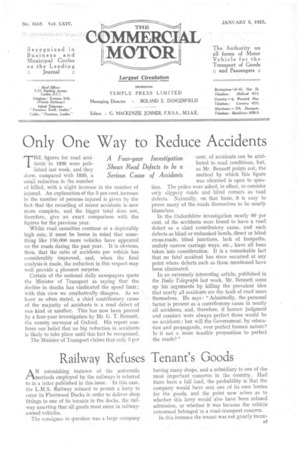Only One Way to Reduce Accidents
Page 21

If you've noticed an error in this article please click here to report it so we can fix it.
THE figures for road accidents in 1936 were pub lished last week, and they show, compared with 1935, a small reduction in the number of killed, with a slight increase in the number of injured. An explanation of the 3-per-cent. increase in the number of persons injured is given by the fact that the recording of minor accidents is now more complete, and the bigger total does not, therefore, give an exact comparison with the figures for the previous year.
• Whilst road casualties continue at a deplorably high rate, it must be borne in mind that something like 150,000 more vehicles have appeared on the roads during the past year. It is obvious, then, that the ratio of accidents per vehicle has considerably improved, and, when the final analysis is made, the reduction in this respect may well provide a pleasant surprise.
Certain of the national daily newspapers quote the Minister of Transport as saying that the decline in deaths has vindicated the speed limit ; with this view we emphatically disagree. As we have so often stated, a chief contributory cause of the majority, of accidents is a road defect of one kind or another. This has now been proved by a four-year investigation by Mr. G. T. Bennett, the county surveyor of Oxford. His report confirms our belief that no big reduction in accidents is likely to take place until this fact be recognized.
The Minister of Transport claims that only 3 per.
Serious Cause
of Accidents method by which this figure was obtained is open to question. The police were asked, in effect, to consider only slippery roads and blind corners as road defects. Naturally, on that basis, it is easy to prove many of the roads themselves to be nearly blameless.
In the Oxfordshire investigation nearly GO per cent. of the accidents were found to have a road defect as a chief contributory cause, and such defects as blind or unbanked bends, direct or blind cross-roads, blind junctions, lack of footpaths, unduly narrow carriage ways, etc., have all been taken into consideration. It is a remarkable fact that no fatal accident has since occurred at any point where defects such as those mentioned have been eliminated.
In an extremely interesting article, published in the Daily Telegraph last week, Mr. Bennett sums up his arguments by killing the prevalent idea that nearly all accidents are the fault of road users themselves. He says : "Admittedly, the personal factor is present as a contributory cause in nearly all accidents, and, therefore, if human judgment and conduct were always perfect there would be no accidents; but will the Government, by education and propaganda, ever perfect human nature? Is it not a more feasible proposition to perfect the roads?"




























































































